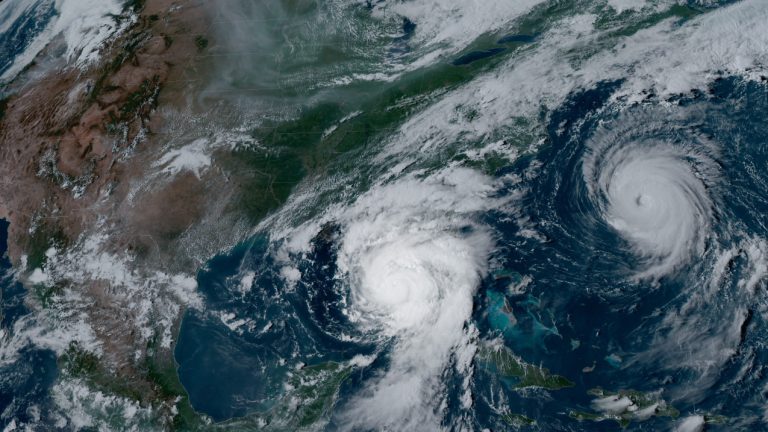Forecasters at the National Weather Service's National Weather Service Climate Prediction Center predict above-normal hurricane activity in the Atlantic basin this year. NOAA's outlook for the 2024 Atlantic hurricane season (June 1-November 30) predicts an 85% chance of an above-normal season, a 10% chance of a near-normal season, and a 10% chance of a below-normal season. The probability is 5% seasonally.
NOAA expects 17 to 25 named storms (winds of 39 mph or higher). Of these, 8 to 13 are expected to become hurricanes (winds of 74 mph or greater), including 4 to 7 major hurricanes (Category 3, 4 or 5; winds of 111 mph or greater). Forecasters have 70% confidence in these ranges.
The upcoming Atlantic hurricane season is expected to be above normal due to a combination of factors, including near-record warm Atlantic ocean temperatures, the development of La Niña conditions in the Pacific, reduced Atlantic trade winds and reduced wind shear, all of which tend to Conducive to the formation of tropical storms.
(Image source: NOAA)
“As another active hurricane season approaches, NOAA remains steadfast in its commitment to reaching every American with life-saving information,” said NOAA Administrator Dr. Rick Spinrad. “AI language translation and new descriptions of inland wind threats in the forecast cone are just two examples of the proactive steps our agency is taking to achieve our mission of saving lives and protecting property.”
“Severe weather and emergencies can happen at any time, which is why individuals and communities need to prepare today,” said Erik A. Hooks, deputy administrator of the Federal Emergency Management Agency. “We're already seeing storms moving across the country with the potential for additional hazards such as tornadoes, flooding and hail. Taking a proactive approach to today's increasingly severe climate situation can make a difference as people recover tomorrow.”
(Image source: NOAA)
As one of the strongest El Niños ever observed nears its end, scientists at the National Oceanic and Atmospheric Administration predict a rapid transition to La Niña, which is good for Atlantic hurricane activity as La Niñas tend to reduce tropical Wind shear in the area. At the same time, abundant ocean heat in the tropical Atlantic and Caribbean creates more energy for storm development.
This hurricane season is also likely to see an above-normal West African monsoon, which could produce African easterly waves that trigger some of the strongest and longest-lasting Atlantic storms. Finally, light trade winds allow hurricanes to gain strength without being disturbed by strong wind shear and minimize ocean cooling. Human-caused climate change is warming oceans around the world and in the Atlantic basin, and melting ice on land, causing sea levels to rise and increasing the risk of storm surges. Sea level rise shows a clear human impact on the potential damage of a given hurricane.
Strengthen in-store communication in 2024 season
NOAA will improve its forecast communications, decision support and storm recovery efforts this season. These include:
- The National Hurricane Center (NHC) will expand its Spanish-language text products to include all public advisories, tropical cyclone discussions, tropical cyclone updates and critical Atlantic basin information.
- Beginning on or about August 15, the NHC will begin issuing experimental versions of forecast cones that include descriptions of inland tropical storm and hurricane watches and warnings in effect for the continental United States. period of outback disasters without overcomplicating the graphics of the current version.
- This season, the National Hurricane Center will be able to issue U.S. tropical cyclone watches and warnings and provide public advisories at regular or intermediate intervals. This means that if updates to storm surge or wind watches and warnings are required, the National Health Commission will be able to notify the public in an interim advisory, rather than having to wait for a full advisory to be issued every six hours.
New tools for hurricane analysis and forecasting this year
- Two new forecast models developed by NOAA researchers will become operational this season: The Modular Ocean Model, or MOM6, will be added to the hurricane analysis and forecasting system to improve representation of the critical role the ocean plays in driving hurricane intensity sex. Another model, SDCON, will predict the probability of rapid tropical cyclone intensification.
- NOAA’s next-generation flood inundation mapping, enabled by President Biden’s bipartisan infrastructure law, will provide emergency and water resources managers with information to prepare for and respond to potential flooding and help local officials better Well prepared to protect people and infrastructure.
- NOAA's Weather Prediction Center, in collaboration with NHC, will release experimental rainfall maps for the Caribbean and Central America for the 2024 hurricane season. This chart provides predicted rainfall totals associated with a tropical cyclone or disturbance during a specified time period.
System upgrade in progress
NOAA will upgrade its observing system, which is critical to understanding and predicting hurricanes. These projects will provide additional observations of the ocean and atmosphere in the Caribbean Sea, Gulf of Mexico, U.S. East Coast, and tropical Atlantic Ocean.
- Starting in June, dozens of observation underwater gliders are planned to be deployed in the Caribbean, Gulf of Mexico and waters off the U.S. East Coast. In addition, a new lightweight dropsonde called Streamsonde will be deployed into developing tropical storms to collect multiple instantaneous observations to collect valuable wind data.
- The CHAOS (Coordinated Hurricane Atmosphere-Ocean Sampling) research experiment is designed to improve understanding of air-sea interactions and provide ongoing monitoring of key ocean features.
About NOAA Seasonal Outlook
NOAA's outlook is for overall seasonal activity, not landfall predictions. In addition to the Atlantic seasonal outlook, NOAA also publishes seasonal hurricane outlooks for the Eastern Pacific, Central Pacific, and Northwest Pacific hurricane basins.
NOAA's Climate Prediction Center will update the 2024 Atlantic Season Outlook in early August, ahead of the season's historic peak.
Climate, weather and water affect all life on our ocean planet. NOAA's mission is to understand and predict changing environments from the deep ocean to outer space and to manage and protect America's coastal and marine resources.
